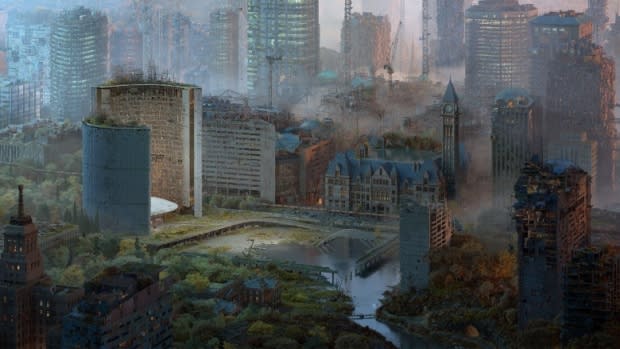Indigenous virtual reality experience heading to Wilfrid Laurier's Brantford campus
A virtual reality project exploring a desolate Toronto from an Indigenous perspective is heading to Wilfrid Laurier's Brantford Campus.
Lisa Jackson, an award winning filmmaker who is Anishinaabe, is the creative director of the virtual reality experience called Biidaaban: First Light, and looks at a version of Toronto if the infrastructure of the city were reclaimed by nature and Indigenous culture.
Indigenous futurism in this piece is a way for me to kind of shake people up and make them think differently. - Lisa Jackson
Viewers will get to take in a "very realistic" version of downtown Toronto through spaces like a subway station, Nathan Phillips Square, and a rooftop, being able to see spaces flooded and overgrown with plants and a starry visible night sky.
"I have to say although some people definitely have that feeling [of it being desolate] a lot of folks have told me they would like to go and live there," said Jackson on CBC KW's Morning Edition.
The project has been described as Indigenous futurism, which Jackson says is a genre in which people project an alternate future that shows Indigenous values, cultures, ideologies, languages and more, "thriving again."

"For me, Indigenous futurism in this piece is a way for me to kind of shake people up and make them think differently through the medium of VR, but just have sort of this fantastical experience," said Jackson.
Creative opportunity
For Jackson, she says the exploration of Indigenous futurism in her piece was focused on Indigenous languages, specifically Mohawk and Ojibwe, and how different they are from English.
"That was a big watershed moment for me where I became really fascinated with 'oh my gosh, these languages are so different,' we would see the world in a completely different way."
Jackson had already been examining Indigenous languages a decade before this project out of pure fascination, and then virtual reality came around and she realized there was "a real opportunity to create something."
The exhibit is a collaboration with the National Film Board who produced the piece and says they "immediately saw the value in it," and Jam 3, a designer and developer to help make it a reality. Shortly after she met Mathew Borrett, a 3D and environment design artist and they created the world from there.

"He adapted his environment that he had been working on for years through his future Toronto series, and we adapted them to this world and it was kind of a great coming together of his visual art and some of the ideas I wanted to express," said Jackson.
Jackson notes there were some challenges, specifically with making the world as realistic as possible. To create the world the way the wanted to, processing power was used in order to help people move around the world and view all the details possible.
She also notes that when adding the Indigenous languages to her virtual reality program that "no one had really done it" and was told she couldn't put text in virtual reality.
"The way we did it, it's not just subtitles it really becomes almost part of the environment that is active and actually engaged with you, you sort of feel connected to it," said Jackson.
The experience will be at Wilfrid Laurier's Brantford Campus Jan. 28 and 29, and is available in English and French.


